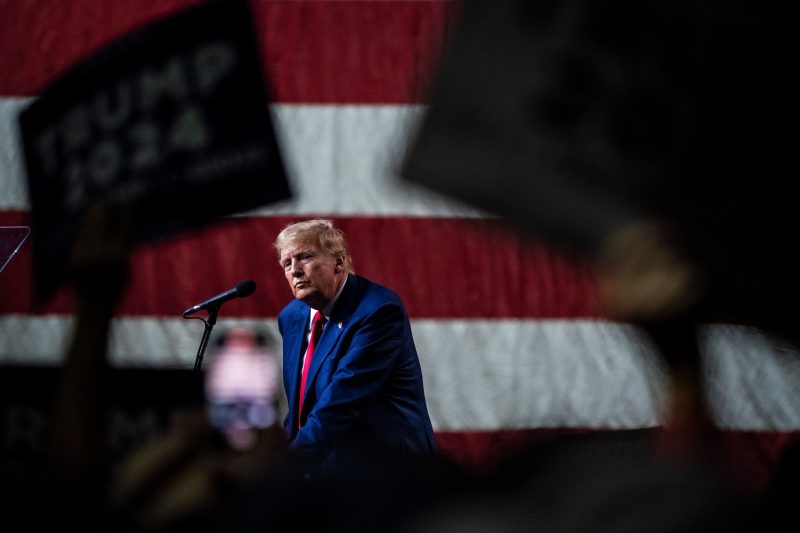Prosecutors have repeatedly described Donald Trump’s false claims of voter fraud in 2020 as effectively manufacturing a pretense for illegally overturning the election. Special counsel Jack Smith said in his indictment of the former president that fake electors were meant to “create a fake controversy” that could be used on Jan. 6, 2021.
In a new filing, Trump’s legal team appears bent on helping prosecutors make that case.
Tucked into Trump’s latest legal brief in his appeal for presidential immunity in his federal Jan. 6 case is a remarkable citation. His attorneys refer to a social media post from Trump the same day of the filing — Tuesday — which links to a report from an unnamed source running down various voter-fraud claims.
The filing cites the report to argue that there remain “vigorous disputes and questions about the actual outcome of the 2020 Presidential election.”
The report, to put it lightly, is a mess. And that Trump’s legal team would see fit to include it in a filing would not seem to augur well for his defense.
The report begins with a series of astonishing and false claims. “In actuality, there is no evidence Joe Biden won,” its first paragraph concludes. It then recounts how Trump led in key battleground states on election night and maintains that, as of that point, before millions of votes were counted, “the election was over.” But even Trump allies had acknowledged before the election that the expected late arrival of ballots from populous and heavily Democratic areas, as well as mail-in ballots, would create an illusion of an early Trump lead — a “red mirage.” There is nothing suspicious about how those states flipped as time went on.
The introductory paragraph also includes a footnote that says Arizona “was fraudulently called for Joe Biden by Fox News” on election night. A network’s calls on any given race do not determine the election, and Biden won Arizona.
The report goes on to cite multiple accounts of alleged fraud that don’t appear to be publicly available.
It cites seven chapters from an apparently voluminous “Report on Widespread Fraud in the Georgia 2020 Presidential Election.” No author or link is provided, nor does a report with such a title appear in a Google search. It also cites claims in 2023 from a woman named Kim P. Brooks, featuring titles that Google doesn’t recognize. Ditto a report from a man named Joseph Rossi called “Risk Limiting Audit Spreadsheet Analysis.”
No links are provided to the claims or documents. A Trump campaign spokesman didn’t respond to a request for the documentation.
The report goes on to cite purported evidence of voter fraud and irregularities in five key states. A sampling:
For Wisconsin, it begins by citing how the state Supreme Court declared ballot drop boxes illegal — but that was in 2022, two years after the 2020 election.For Pennsylvania, it cites the idea that there were more votes than voters. This is an oft-cited claim based on lagging data from a database called the Statewide Uniform Registry of Electors (SURE). Such claims were debunked both before Jan. 6 and long after.For Arizona, it begins by claiming Maricopa County illegally accepted 20,000 absentee ballots after the deadline of 7 p.m. on Election Day. Multiple fact checks have noted that this assertion relies on a misreading of the dates; the dates actually indicate when the ballots were handed off to a private vendor for scanning, not when they were received.Perhaps most remarkably, it cites this anecdote from Michigan: “A city clerk in Muskegon witnessed a woman drop off between 8,000 and 10,000 voter registrations at the clerk office on Oct. 8, 2020, many appearing to be fraudulent.” We’ve already known that those registrations were caught even before the election and that no fraudulent registrations appear to have resulted in actual votes. But as it happens, on Wednesday morning, The Washington Post’s Sarah Ellison published a thorough debunking of claims linking the Muskegon situation to any fraudulent ballots.
These are just a few examples of the claims that have already been debunked or have no actual proximity to voter fraud. Many of the claims don’t appear to have been publicly lodged before the report’s release Tuesday and are difficult to trace because of the scant sourcing. Most of the report is devoted to supposed procedural irregularities that say nothing about a stolen election.
At this point, it should be no surprise that Trump would press forward with promoting false voter-fraud claims. He has been doing it for more than three years, despite all the evidence to the contrary.
But it’s one thing to say these things in public; it’s quite another to include them in a legal filing. Trump’s attorneys have been careful not to actually vouch for his wildest claims, because doing so involves trying to substantiate them, and legal scrutiny has been unkind — to put it mildly.
Trump’s lawyers do not say that the claims in the report are true, instead using the document in an effort to substantiate the idea that there remain “vigorous disputes” and “questions” about the results. The aim is to apparently cite the smoke without actually claiming there’s fire.
But what it demonstrates is how much this entire effort was about manufacturing smoke. And in that way, the Trump lawyers in effect just proved the prosecutors’ point.

